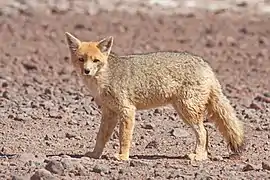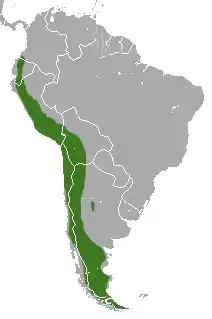Culpeo
The culpeo (Lycalopex culpaeus), sometimes known as the zorro culpeo, Andean zorro, or Andean fox, is a species of South American fox. Regardless of the name, it is not a true fox, but more closely related to wolves and jackals. Its appearance resembles that of foxes due to convergent evolution.
| Culpeo | |
|---|---|
 | |
| Scientific classification | |
| Kingdom: | Animalia |
| Phylum: | Chordata |
| Class: | Mammalia |
| Order: | Carnivora |
| Family: | Canidae |
| Genus: | Lycalopex |
| Species: | L. culpaeus |
| Binomial name | |
| Lycalopex culpaeus (Molina, 1782) | |
 | |
| Culpeo range | |
It is the second-largest native canid on the continent after the maned wolf. In appearance, it bears many similarities to the widely recognized red fox. It has grey and reddish fur, a white chin, reddish legs and a stripe on its back that may be barely visible.
The culpeo's diet consists largely of rodents, rabbits, birds and lizards, and to a lesser extent, plant material and carrion. The culpeo does attack sheep on occasion and is therefore often hunted or poisoned.[2] In some regions, it has become rare, but overall the species is not threatened with extinction.
The culpeo was domesticated to form the Fuegian dog, but this animal is now extinct.[3]
Description

The culpeo is a canid intermediate in size between a red fox and a coyote. The average weight of the male is 11.4 kg (25 lb), while the typically smaller females average 8.4 kg (19 lb). Overall, a weight range of 5 to 13.5 kg (11 to 30 lb) has been reported. Total length can range from 95 to 132 cm (37 to 52 in), including a tail of 32 to 44 cm (13 to 17 in) in length.[4] The pelt has a grizzled appearance. The neck and shoulders are often tawny to rufous in color, while the upper back is dark. The bushy tail has a black tip.[5]
Range

Its distribution extends from Ecuador and Peru to the southern regions of Patagonia and Tierra del Fuego. Some populations live in southern regions of Colombia. It is most common on the western slopes of the Andes, where it inhabits open country and deciduous forests.
Habitat
The culpeo lives in a wide variety of habitats of western South America. They are found in broadleaf Nothofagus temperate rainforest, sclerophyllous matorral, deserts, and plateaus, like the Altiplano, up to the tree line (4,800 metres (15,700 ft)).[1]
Diet

The culpeo fox is an opportunistic predator that will take any variety of prey. This fox mainly feeds on rodents and lagomorphs (especially the introduced European rabbit and European hare); however, it occasionally feeds on domestic livestock and young guanacos.[6] Culpeos are considered beneficial because they are significant predators of the rabbits introduced in 1915; such introduced rabbit populations are believed to have allowed culpeos to spread from the Andean foothills across the Patagonian plain.[7] They sometimes take young lambs up to a week old. In limited studies, the larger culpeo appears to dominate potential competitors, including South American gray foxes, Geoffroy's cats, pampas cats, grisons and various raptorial birds.[5] Its range also overlaps that of the much larger puma, but the size difference ensures that the two species have limited competition. They are known to eat the carrion of vicuñas.
Reproduction
The typical mating period is between August and October. After a gestation period of 55–60 days, the female gives birth usually to between two and five pups.
Classification
Subspecies
 Lycalopex culpaeus andinus (Thomas, 1914)
Lycalopex culpaeus andinus (Thomas, 1914) Lycalopex culpaeus culpaeus (Molina, 1782)
Lycalopex culpaeus culpaeus (Molina, 1782) Lycalopex culpaeus lycoides (Philippi, 1896)
Lycalopex culpaeus lycoides (Philippi, 1896) Lycalopex culpaeus magellanicus (Gray, 1837)
Lycalopex culpaeus magellanicus (Gray, 1837) Lycalopex culpaeus reissii (Hilzheimer, 1906)
Lycalopex culpaeus reissii (Hilzheimer, 1906)
Taxonomy
The taxonomy of the culpeo has been the topic of debate due to their high phenetic variability and the scarcity of research, among other things. Over the past three decades, they have been placed variably in the genera Dusicyon (Clutton-Brock, et al., 1976; Wozencraft, 1989), Canis (Langguth, 1975; Van Gelder, 1978), Pseudalopex (Berta, 1987; Wozencraft, 1993; Tedford et al., 1995) and Lycalopex (Zunino, 1995; Wozencraft, 2005).[8]
This canid, like other South American foxes, is still sometimes classified as a member of the genus Pseudalopex.[1] As Pseudalopex and Lycalopex have largely come to describe the same genus, either classification is acceptable, although the modern practice is to give Lycalopex prominence.[9]
| Cerdocyonina[10] |
| |||||||||||||||||||||||||||||||||||||||||||||||||||||||||
References
- Jiménez, J. E.; Lucherini, M. & Novaro, A. J. (2008). "Pseudalopex culpaeus". IUCN Red List of Threatened Species. 2008. Retrieved 18 June 2012.CS1 maint: ref=harv (link)
- Macdonald, David Whyte; Claudio Sillero-Zubiri (2004). The Biology and Conservation of Wild Canids. Oxford University Press. ISBN 978-0-19-851555-5.
- Petrigh, Romina S.; Fugassa, Martin H. (December 13, 2013). "Molecular identification of a Fuegian dog belonging to the Fagnano Regional Museum ethnographic collection, Tierra del Fuego" (PDF). Quaternary International. 317: 14–18. doi:10.1016/j.quaint.2013.07.030. Archived from the original (PDF) on December 20, 2016. Retrieved September 2, 2020.
- Burnie D and Wilson DE (Eds.) (2005), Animal: The Definitive Visual Guide to the World's Wildlife. DK Adult, ISBN 0789477645
- Andrés J. Novaro (24 October 1997). "Pseudalopex culpaeus" (PDF). Mammalian Species. American Society of Mammalogists (558): 1–8. doi:10.2307/3504483. JSTOR 3504483. Archived from the original (PDF) on 2013-05-14 – via www.science.smith.edu.
- Andres J. Novaro, Claudio A. Moraga, Cristobal Bricen, Martin C. Funes, Andrea Marino (2009) First records of culpeo (Lycalopex culpaeus) attacks and cooperative defense by guanacos (Lama guanicoe). Mammalia, Volume 73
- Alderton, David. Foxes, Wolves, and Wild Dogs of the World. London: Blandford, 1998. p175-6.
- Jiménez, J.E.; Novaro, A.J. (2004). "Chapter 3.4: Culpeo (Pseudalopex culpaeus)". In Sillero-Zubiri, C.; Hoffmann, M.; Macdonald, D.W. (eds.). Canids: Foxes, Wolves, Jackals, and Dogs. Archived from the original (PDF) on 2011-10-06. Retrieved 2012-05-08.
- Wozencraft, W.C. (2005). "Order Carnivora". In Wilson, D.E.; Reeder, D.M (eds.). Mammal Species of the World: A Taxonomic and Geographic Reference (3rd ed.). Johns Hopkins University Press. pp. 579–581. ISBN 978-0-8018-8221-0. OCLC 62265494.
- Wang, X.; Tedford, R.H. (2007). "Ch1-Evolutionary History of Canids". In Jensen, Per (ed.). The Behavioural Biology of Dogs (1 ed.). Cabi Publishing. p. 11. ISBN 978-1845931872.
- Lindblad-Toh, K.; Wade, C.M.; Mikkelsen, T.S.; Karlsson, E.K.; Jaffe, D.B.; Kamal, M.; Clamp, M.; Chang, J.L.; Kulbokas, E.J., 3rd (2005). "Genome sequence, comparative analysis and haplotype structure of the domestic dog" (PDF). Nature. 438 (7069): 803–819. doi:10.1038/nature04338. PMID 16341006.
| Wikispecies has information related to Lycalopex culpaeus. |
| Wikimedia Commons has media related to Pseudalopex culpaeus. |
